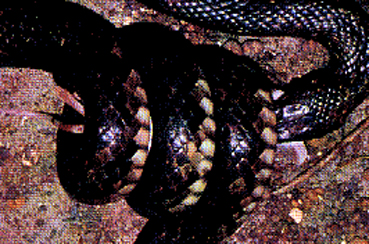
INTRODUCED MOUSE
(MUS MUSCULUS)

During the latter part of 1993 there were several reports in the media concerning mouse plagues in parts of the South Australian agricultural region. The economic cost of this was reported at $50 million. The SA Minister for Agriculture approved the use of strychnine to control the mice.
It is probable that large numbers of native predators of introduced mice, ie monitor lizards, snakes and raptors, were the victims of secondary poisoning after consuming freshly killed mice.
This evaluation is an attempt to determine the economic value of a snake to the community. See Bush (1994) for a review of the minimal danger to people by snakes in Australia.
For conservatism in the results the following projections and calculations are based on:-
a) A single individual of any Pseudonaja spp. (commonly called brownsnakes) except the Ringed Brown Snake (P. modesta), which have been highly successful occupying agriculturally developed areas and as subadults and adults feed largely on mice (Mus musculus).
b) The assumption that an individual brownsnake may feed on mice for 6 months of each year for 4 years. During this time it will consume 10 mice each month totalling 240 during its life.
c) Females make up 25% of mice consumed and a minimum of 25% of all mice reproduced are female.
d) 10 generations of mice with each female producing 16 offspring. A single female mouse may have 6 to 10 litters per year with 4 to 8 pups in each litter (Laurie Twigg, Pers Comm.).
e) An adult mouse weighing 20 grams and consuming its weight in grain once during its life.
f) On grain consumed irrespective of the extra damage caused to stored feed and materials. Because much of the grain lost to mice is pre-harvest/pre-freight, ie at various points along the production line, I have placed a value of only $50 per tonne on this.
The projected benefit of a snake removing 240 mice (60 of which are female):
If allowed to breed and contribute to the local population the total mice, originating from these 240, consuming grain after 10 generations is 335,544,240.
Multiplied by 20 grams = 6,710,884,800g
or....................... = 6,710.9 tonnesThis is a very conservative estimate of the economic value of a snake as a naturally occurring predator on mice. A snake's adult longevity is of greater duration than 4 years. I have kept a Dugite or Spotted Brown Snake (P. affinis) collected as an adult in 1979 for 20 years to date and a Gwardar or Western Brown Snake (P. mengdeni) collected in 1986 as an adult for 13 years. Also, the number of mice a snake consumes used here does not take into consideration the baby and immature mice eaten, ie an individual snake will consume all the neonatal mice in any nest encountered.
A mouse would probably consume its weight in grain every couple of days rather than once during its life. Yes, $335,545.00 is conservative but, even so, on this figure 100 extra snakes existing in the agricultural region of South Australia effected by the 1993 mouse plague would probably have controlled the mice numbers to the degree that a plague may never have occurred. At least the extra 100 snakes would offset to a large degree the $50 million loss ($335,545 X 100 = $33.5 million).
Bush, B. 1994. Australia's venomous snakes: the modern myth. Presented at the Second World Congress of Herpetology, Adelaide, South Australia.
E-mail bush@iinet.net.au